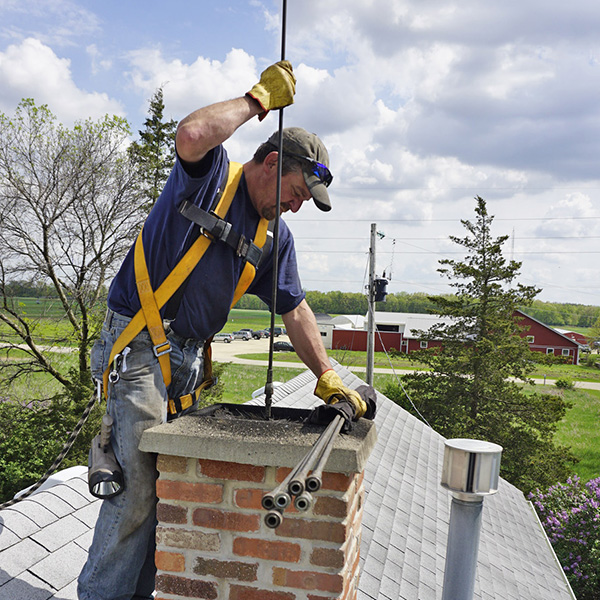What Toxic Substances are in My Chimney?
Creosote and soot are byproducts of wood combustion, and both are flammable, toxic materials. Creosote buildup in your chimney creates obstruction and fire hazards. Many people are aware of the problem of creosote and try various solutions to reduce the amount of buildup in their chimneys. Some chemical products are available that claim to provide protection against excess creosote, but is it safe to use them? Below, learn more about creosote and soot than you’ve probably known before plus find out what fire safety experts think of using chemicals for creosote control.
 Soot
Soot
A byproduct of wood combustion, chimney soot is a fine powder that is black or dark brown in color. Soot is formed in temperatures lower than 284º F. The normal temperature range of wood fires is 500º F to 1000º F. As wood is breaking down, it develops into this dusty powder. The yellow and reddish orange colors in fires are caused by soot. Because of its texture and consistency, soot tends to stain ventilation systems, clothing, floors, ceilings, walls, and even skin. With excessive exposure, it can also be a health threat. Soot can contain polycyclic aromatic hydrocarbons and other carcinogenic compounds. Able to enter your body through ingestion, inhalation, the skin, and eyes, soot can cause respiratory issues. Infants, the elderly, and others who are vulnerable to breathing problems are most at risk.
What Exactly is Creosote?
Creosote, also a byproduct of wood combustion, consists primarily of tar. The smoke rising from open flames contains traces of creosote. As the smoke travels up the chimney, it mixes with moisture and cold air, which causes it to solidify and stick to the chimney flue. The primary danger created by creosote is the flammability of the substance. The risk of a dangerous chimney fire increases as more creosote is deposited in the chimney lining.
Three Stages of Creosote
 Removing creosote is easy when it is in its Stage 1 form. A professional chimney cleaning brush is all that is needed to remove Stage 1 creosote.
Removing creosote is easy when it is in its Stage 1 form. A professional chimney cleaning brush is all that is needed to remove Stage 1 creosote.
Stage 2 creosote is usually described as crunchy, tar-like flakes. Stiffer chimney brushes plus additional tools of the chimney sweep industry are typically required to scrape Stage 2 creosote from chimney liners.
If you have Stage 3 creosote in your chimney, it looks as though tar has been poured down your chimney flue. This is the most dangerous type of creosote because it is easiest to ignite, and it often feeds a chimney fire for a long enough time that the intense heat destroys the chimney liner and then the entire home. professional chimney sweeps have the tools necessary for removal of Stage 3 creosote, though tools are not always completely successful. Chemicals can sometimes be used to good effect by chimney professionals in the effort to remove Stage 3 creosote. Unfortunately, there are times when the creosote will not come off and a chimney liner replacement is necessary, to ensure the safe use of a fireplace.
Are Chemical Products Good for Homeowners to Use?
The chemical products that claim to help maintain a clean chimney have been around for a while. The Chimney Safety Institute of America (CSIA) is a leading fire safety organization. CSIA has addressed the issue of chemical chimney cleaners. The crux of their position is that nothing can replace routine chimney cleaning by a chimney professional. Chemicals alone could never do an adequate job. One reason is because the creosote that falls down the chimney can cause an obstruction within the venting system.
Contact Dubuque Fireplace & Heating
Chimney maintenance is an important safety issue for your home and family. All leading safety experts agree that annual chimney inspections are essential. The National Fire Protection Association (NFPA) recommends annual chimney sweeping, as well. CSIA suggests that it’s time for chimney cleaning when there is a layer of creosote and soot in the chimney liner that measures 1/8” or more.
Call us at Dubuque Fireplace and Heating for chimney sweeping, chimney inspections, chimney repair, masonry repair, flashing leaks, chimney crown rebuilds, fireplace remodels, and more. Contact us today! See the details of our locations and phone number options below.
Dubuque Fireplace & Patio
925 Century Drive, Dubuque, Iowa
Phone – (563) 582-5156
Chimney Specialists Inc.
869 Main Street, Highland, WI
Phone – (608) 929-4887 / Toll Free (800) 395-6660



















